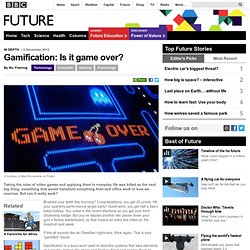

The power of play: Gamification and home care - Home Care Daily News - McKnight's Senior Living. All leaders struggle with finding ways to keep team morale high and staff members motivated to provide excellent service.

In the home care world, low morale and unmotivated caregivers can lead to a litany of issues ranging from poor care to a lackluster reputation to increased turnover. As home care leaders look to improve their team communication and compliance, they often overlook how technology can provide a way to meaningfully connect with their team and enhance the work experience.
Gamification: 75% Psychology, 25% Technology - The BrainYard - Gamification guru Gabe Zichermann on how to make applications addictive.

Slideshow: 14 Leading Social CRM Applications (click image for larger view and for slideshow) Should enterprise applications be as addictive as Angry Birds? A true believer in gamification would say yes, if you want people to actually use them. Gamification is broken. An interview with Steven Poole « G. What is gamification? Gameplay has a lot to teach us about motivating participation through joy.

‘Gamification’ is a new term, coined in 2008, for adapting game mechanics into non-game setting — such as building online communities, education and outreach, marketing, or building educational apps. Gamification time: What if everything were just a game? 21 June 2011Last updated at 00:15 By Katia Moskvitch Science and technology reporter, BBC News How Microtask's Digitalkoot game helps weed mistakes out of the Finnish National Library's e-archives One more step, and a tiny creature will cross the bridge and get to safety.

Just one more step - but letters do not match, the fragile structure blows up and the brown mole falls into a digital abyss. But as Juha Valtamo, a 21-year-old Finnish student, correctly types the next word that appears on the screen of his laptop, another mole happily reaches the destination. Technology - Gamification: Is it game over? Taking the rules of video games and applying them to everyday life was billed as the next big thing, something that would transform everything from dull office work to how we exercise.

But can it really work? Brushed your teeth this morning? Congratulations, you get 20 points. Hit your quarterly performance target early? Good work, you get half a day's extra holiday. Top Career Opportunities and Jobs in Gamification. What jobs in gamification are out there?

One of the questions I’m asked most frequently is how to build a career in or with gamification. The industry is growing rapidly, with companies on track to spend over $2.5Bn directly on gamification products and services by 2016, with at least 5,000 jobs created as a result. eLearning & Gamification: The Octalysis Framework. By AJ George After covering gamification in a few articles, I've been getting lots of feedback requesting more information. I've been doing a bit of research recently and came across the Yu-kai Chou & Gamification Blog. If you're interested in gamification in general, you should definitely add this blog to your RSS feed. What I found particularly interesting to the eLearning community, however, was Yu-kai's gamification framework for increasing user engagement and motivation. Judging by the feedback I received on my article How to Incorporate Gamification Elements, I think the question eLearning developers are facing is not whether to add gamification elements at all, but how to determine which gaming elements will be most helpful to encourage motivation, keep learners interested, and achieve the desired learning outcomes.
Playful Design and User Experience in Practice: eCommerce Search. We refer to "playfulness" in user experience when talking about interface or design elements that are aimed to let the users play. There a number of different explanations to this technique; here's my favorite one: When designing a website, we usually focus on definitive paths that would bring the user to our ultimate goal (or goals) - be it a sign-up page, shopping cart or anything else. With playful user experience we do the opposite thing: we try to stop the user's browsing and let him play. In other words, we try to distract the user from his initial aim and let him enjoy himself. Thoughts about Gamification, Technology and Games. Playfulness in Interaction Design. I recently attended a lecture by Matt Jones on the topic of Playful Design.
Matt was talking primarily about engaging users and customers through a process of playful discovery, in which fun and quirky features are designed into products, allowing users to engage in entertaining passive exploration of the product. Playful features could have a purpose or simply be there as a wink to the user. The main idea is to create an atmosphere of play that enhances the intrinsic value of the software or product. This playful attitude can be added as part of error messages, quirky functions, or in-product mini-games. Although the lecture didn’t really focus in any specific product categories, the overall concept seemed to be aimed at electronic consumer devices, social networks, and the kind of fast & fun web 2.0 applications that are popping up like mushrooms. Another fun example is Twitter. Real Gamification Mechanics Require Simplicity And, Yes, Game Designers Can Do It.
Editor’s note: Tadhg Kelly is a game designer with 20 years experience.

He is the creator of leading game design blog What Games Are, and consults for many companies on game design and development. You can follow him on Twitter here. My gamification post two weeks ago (which described everything you really need to know) struck some nerves, especially as it came out just before a Gartner report claiming that 80 percent of gamified projects would fail. I received emails from several folks who had unsuccessfully tried to gamify their service and found the process frustrating, or felt that they had been sold some snake oil. Most commonly this was because they got caught up in the seductive fantasy of the engaged user who interacts on multiple levels rather than focusing on specific outcomes.
Just add points? What UX can (and cannot) learn from games. What is Gamification, Really? Michael Wu, Ph.D. is Lithium's Principal Scientist of Analytics, digging into the complex dynamics of social interaction and group behavior in online communities and social networks.

Design for Motivation - Intrinsic and extrinsic motivation in design. Features - Gamification Dynamics: Growth And Emotion. [In the first installment of this series, Badgeville's Tony Ventrice looked to frame the discussion around what's possible with gamification by attempting to discover what makes games fun.

In this article, Ventrice delves into the first two of his seven identified dynamics of game design.] Growth describes a sense of direction and progress. It is a fundamental aspect of humanity, the first great challenge of adulthood, and a typical source of midlife crisis. When you ask a child what they want to be when they grow up, you're asking about their plan, their direction for life. When, old and shrunken, you look back over your life, satisfaction lies in what you've accomplished. Levelling Up, Rewards & Having Fun. For those who are new to the whole term and discussion of gamification here’s a quick and basic 101 on the subject from my experience at the conference: Great games are built around a narrative the players / users to interact with whilst completing tasks, getting rewarded, levelling up and having fun.

A great introduction to think about game theory is the Bartle’s Test (created in 1996), which attempts to defines what player type you are in an online game (take the test). There are four: This has been used by creators to steer game development although the majority of people are socialisers (hence the popularity of social gaming in the last few years). I really liked Jon Radoff’s challenge and approach to designing games as experiences. A HUGE part of gaming is the reward mechanisms. Putting the Fun in Functional: Applying Game Mechanics to Functional Software.
Strategic Synergy. Gamification: Is it really just a bunch of bull? It's always surprising just how polarizing the idea of gamification is. Some people love the concept of adding game-like elements to all different types of social and commercial interactions, while others hate it with a seething vehemence, either because they're "gamers" who hate seeing their favorite art form debased, or because they're anti-gamers, who don't see the need to make everything in life so damned amusing.
Gamification is Bullshit. Comments (149) Want to comment on your site? The trackback URL is Seemed over the top until i heard some gamification proponents speak. i still think creating participant structures that correspond to real world actions 1) will be done, and 2) can be done in more humane, just, and pleasurable ways. As an educator, I do this all the time (of course, as do you). The # gamification Daily. Christian charity turns to gamification to engage young. Tearfund, the Christian international aid charity, is looking to drive engagement with young supporters with the launch of a mobile gaming platform.
How Turntable Nailed the Gamification Challenge. Turntable.fm is taking over the ear drums of social music listeners everywhere. The Gamification of News. “Gamification” seems to be the up and coming buzz word. Why It's Important to Be Able to Play at Work Infographic. Customer Experience Blog » Gamification: another buzz word or a real ‘game changer’? What Web Designers Can Learn From Video Games - Smashing Magazine. Advertisement Games are becoming more Web-like, and the Web is becoming more game-like. If you need proof of this, you have only to look at Yahoo Answers. Random questions are posed, the top answer is chosen, and credibility points are given to the winner. SEO Tips for Your Blog > Smart Insights Digital Marketing. My experience with clients, is that businesses that produce high quality blogs produce positive results.
Killer-blog-design.jpg (JPEG Image, 1300x2140 pixels) - Scaled (46%) REVEALED: The Secret To Accenture’s Social Business Adoption Success (Hint: It’s Gamification) There are a few sensations in life that manage to thrust us into action, or provoke us to work without a motive. Sensations so powerful that we fall victim to a form of altruistic amnesia. We’re driven by its hidden motivational forces and we forget the benefits are for someone else. In short, neither lack of advantage nor lack of compensation deter us.
Gamification: Future or Fail? Learning from game design: 11 gambits for influencing user behaviour. Games are great at engaging people for long periods of time, getting them involved, and, if we put it bluntly, influencing people’s behaviour through their very design. Something conspicuously missing from Design with Intent v.0.9 is a satisfactory treatment of the kinds of techniques for influencing user behaviour that can be derived from games and other ‘playful’ interactions. I hope to remedy this in DwI 1.0, so here’s a preview of the eleven patterns I’ve included in the new Ludic Lens on behaviour change: patterns drawn from games or modelled on more playful forms of influencing behaviour.
These aren’t original, by any means. People such as Amy Jo Kim (see her great presentation ‘Putting the fun in functional’), Sebastian Deterding, Francisco Inchauste, Jeremy Keith, Geke Ludden, and of course Ian Bogost have done work which explores this area from lots of different angles, and it also draws on decades of research in social psychology. Seth Priebatsch: The game layer on top of the world. Jesse Schell: When games invade real life. Game mechanics for thinking users « Homo Surfens. Game mechanics for thinking users Posted by Pietro Polsinelli on November 9, 2010 · 12 Comments Many software applications and web sites that are not commonly understood as games have some aspect that can be described in gaming terms.
Game Mechanics, Badges & eBay Feedback Ratings. Why Both Intrinsic and Extrinsic Motivators Matter in Gamification « Strategic Synergy. Dan Ariely, a Professor of Psychology and Behavioral Economics at Duke University wrote a book titled Predictably Irrational where he describes the difference between Intrinsic and Extrinsic Motivators and how these affect management decisions in driving employee behavior .
Ariely suggests that moving from extrinsic motivators or rewards such as money, points or schedules, to intrinsic motivators or internal needs including friendship, commitments , and loyalty, is in essence making a move from a market relationship to a social relationship. Gamification – what is it and why is it important? > Smart Insights Digital Marketing. 12 Most Sneaky Ways That Gamification is Playing You. There Be Dragons: Ten Potential Pitfalls of Gamification. What are the do’s and don’ts when introducing game mechanics in a website?
Why does gamification so often fail? More Than Points: Architecting Engagement Through Game Design Thinking. Don't Play Games With Me! Promises and Pitfalls of Gameful Design.